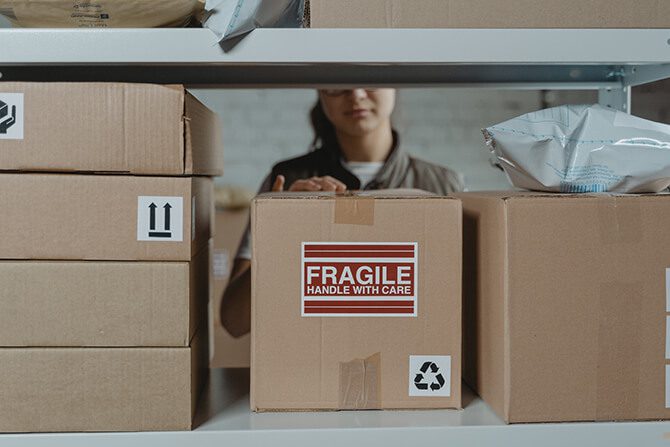
Trying to ship temperature-controlled cargo is a difficult task, even for more experienced companies. There is more to maintaining a steady temperature around your shipment than simply putting it in a climate-controlled unit. As you’ll soon learn, there are multiple factors that you need to tackle and various aspects you need to plan. So, let’s take a closer look at what shipping temperature-sensitive cargo truly entails.
How do you ship temperature-controlled cargo – step by step
While the process of shipping temperature-sensitive cargo can be pretty complex, organizing it is surprisingly straightforward. There are clear steps you need to take to prepare both your items and the parties that will handle them. If you tackle these steps with due care, you should be primed and ready to safely ship your cargo. But, keep in mind that, as with virtually any type of shipping, unexpected problems can occur. And being able to tackle those problems is a vital skill.
1. Outline your requirements
Simply stating that you need your cargo to remain in temperature-controlled storage units won’t do you much good. To provide full protection, you need to clearly outline the conditions that you need for your items, from start to finish. The company that helps you ship your cargo needs to be aware of:
- Acceptable temperature ranges;
- Equipment requirements;
- Special handling instructions;
- Procedures for accepting (or rejecting) freight at delivery.
By outlining and providing this information in advance, you will ensure that the whole shipping process is smooth. Furthermore, by knowing what you need, you will have a much easier time finding the people who can help you out.
 The better you understand your items, the easier it will be to ship temperature-sensitive cargo.
The better you understand your items, the easier it will be to ship temperature-sensitive cargo.
2. Find a reliable temperature-controlled shipping partner
A temperature-controlled shipping partner, as a rule, needs a fair bit of oversight. You may get away with an average logistics partner if you are simply transporting something from point A to point B. But, for a more complex supply chain, you will need to work with someone who has prior experience. Apart from them being able to fill your requirements, you should also inquire about:
- Security protocols;
- Temperature monitoring capabilities;
- Equipment testing procedures and general equipment age;
- Delivery performance;
- Previous instances of shipping temperature-controlled cargo.
The more you can learn about your logistics partner, the safer you will feel handing over your cargo to them. So, do yourself a favor and take your time checking who you associate yourself with.
3. Proper packing
Temperature-controlled storage units will help in protecting your cargo. But, they can only do so much. To truly protect your cargo, you need to pack it properly first. Padding and wrapping materials are a must, especially if there is a chance that your items will shift during transport. Furthermore, you want to use EPS foam to help regulate temperature. Gel packs and dry ice are also viable options. But, it would be best if you studied how to use them properly before investing in them.
4. Documentation
Along with outlining your requirements, you should also ensure that you have the correct documentation for your cargo. The last thing you want is for your items to get stuck in customs simply because you didn’t get the necessary paperwork on time. So, start gathering paperwork in advance. Ideally, if you are shipping your items to a different country, you will have important documents translated. In fact, some countries will require you to do so. Also, make sure that the person handling your cargo is familiar with the necessary documentation and that they have a basic understanding of what it means.
5. Loading and unloading
While your shipping company will take care of the temperature during transport, you should consider what happens during loading and unloading. Namely, not all loading and unloading points have temperature-controlled areas. In this case, you need to find a way to maintain the temperature of your items, even when they leave the containers.
The last thing you want is for your temperature-sensitive items to sit in the sun.
In most cases, you can prepare a temperature-controlled unit in advance. But, you need to start addressing that week before your actual shipment. All the people that handle your cargo should be aware of its fragility and specific requirements.
6. Get the right insurance
Before you sign off your cargo to a shipping company, know that their standard insurance might not properly cover your cargo. Namely, if your items are particularly valuable, the standard shipping insurance may not be enough if something unexpected happens. And even if it seems enough, it may have a loophole through which the shipping company can avoid paying. If necessary, have a lawyer go through your document to ensure that you are fully covered.
Final thoughts on Temperature-control services
What we’ve outlined so far should enable you to safely ship temperature-controlled shipping. But, alas, unfortunate circumstances do happen. Dealing with them takes experience, knowledge, and primarily attention. Even with proper coverage and insurance, you need to get live updates on your cargo. Modernized shipping companies have the necessary technology to provide you with regular updates on possible delays. And the better you are ready to address and deal with those delays, the less they will cost you. Ideally, you will also get information about the current temperature of your cargo and receive proactive notification if something goes wrong.

Caption: 90% of dealing with shipping is knowing how to deal with delays.
This is another reason why finding logistics partners and shipping companies with experience is vital. You can risk working with a less experienced company that perhaps offers a better price for more resilient cargo. But, if you want to ship temperature-sensitive cargo safely, you need to have experienced people by your side. Even with the utmost attention, there are some problems that only they can solve. Luckily, due to recent events, a large number of companies had to incorporate cold chains. So, you shouldn’t have much of a problem finding a suitable company to help you out.


